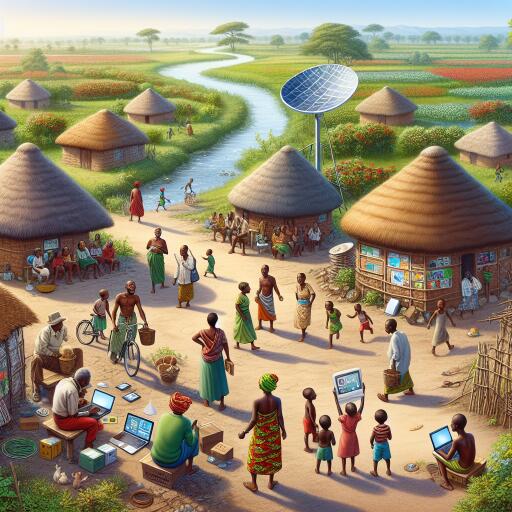
Village Rhapsody: Zimbabwe’s Leaders Must Prioritize Digital Inclusion for Rural Communities
In the evolving landscape of today’s digital age, technology access is no longer a luxury but a necessity driving economic progress, social growth, and worldwide connectivity. Yet, within Zimbabwe, this digital evolution has not been equitably distributed. While urban centers are rapidly embracing digital technology, rural communities face a daunting digital divide. Many lack fundamental infrastructure such as electricity and Internet connectivity, isolating them from the opportunities that digital innovations present.
The consequences of this divide are far-reaching, impacting economic growth, educational opportunities, and social integration. The gulf in digital access also threatens to erode traditional knowledge and skills, further deepening cultural divides.
The Impact of the Digital Gap on Education
Education stands as a pivotal pillar for any community’s development. However, in Zimbabwe’s countryside, the digital disparity significantly hampers educational opportunities. The scarcity of resources, including outdated textbooks and absent computer labs, restricts the ability of rural students to develop essential digital competencies. Such educational imbalances trap rural generations in a cycle of poverty, narrowing their future potential and prospects.
Health Services and the Digital Divide
Access to comprehensive healthcare is a fundamental right, yet the digital gap imposes a heavier burden on rural health services in Zimbabwe. Telemedicine, which could revolutionize healthcare access by bringing medical expertise to remote locales, is largely inaccessible due to poor connectivity. This reality leaves rural communities vulnerable to delayed medical advice, diagnoses, and treatment, heightening health risks and preventable fatalities.
Economic Empowerment and Digital Exclusion
The digital divide stunts economic empowerment and entrepreneurial capacity within rural regions. With limited access to online marketplaces and financial services, rural entrepreneurs struggle to expand their consumer base and secure financial backing. This lack of digital tools perpetuates poverty and broadens the income gap between urban and rural areas, undermining economic advancement.
Learning from Global Success Stories
Worldwide, various countries have pioneered effective interventions to bridge their digital divides, offering valuable insights for Zimbabwe.
South Korea has led the charge with its “Smart Learning” initiative, endowing all academic institutions with high-speed Internet and digital education programs. “Smart learning centers” have been introduced in rural areas, equipped with digital resources to bolster educational prospects.
Kenya’s innovative “digital village” model establishes community telecentres, enabling Internet access, computer skills training, and diverse digital services for rural populations. Such community-driven projects are facilitated through government-private sector alliances, thereby opening up avenues for information, education, and economic engagement.
Uruguay’s “Plan Ceibal” ambitiously equips every child with a laptop and Internet access, spanning both urban and rural environments. This program ensures the distribution of digital resources and the enhancement of educational opportunities, coupled with teacher training to improve digital literacy.
Towards a Comprehensive Digital Strategy for Zimbabwe
Inspired by the global landscape, Zimbabwe can carve a path to bridging its own digital chasm through a multifaceted strategy.
Infrastructure Expansion: Prioritizing the enhancement of broadband connectivity and reliable power infrastructures is crucial. Investments in telecommunications networks, fiber-optic installations, and renewable energy solutions, especially solar power, are essential. Countries like South Korea offer a blueprint for effective infrastructural advancements.
Implementing Digital Literacy Programs: Targeted programs for both students and rural adults should emphasize foundational digital skills, such as navigating the Internet, online safety, and digital communication. Lessons from India’s digital literacy efforts provide a framework for devising tailored training initiatives in Zimbabwe.
Encouraging Community Participation: Integrating local communities in the development, deployment, and administration of digital initiatives promotes a sense of ownership. Establishing community internet centers, akin to the models in Kenya and Uruguay, supports digital interaction, education, and entrepreneurship, empowering community members to drive change.
Adapting to Local Needs: While drawing inspiration globally, it’s critical that adaptations suit Zimbabwe’s unique socio-cultural and economic contexts. Solutions attuned to the specific necessities of rural communities will ensure the efficacy and relevance of digital inclusion strategies.
By adopting and adapting effective models from around the globe, Zimbabwe stands poised to transcend the digital divide that encircles its rural landscapes, fostering inclusive growth and empowering its population. Such progression not only enhances individual lives but also invigorates the nation’s overall economic and social framework.





Leave a Reply